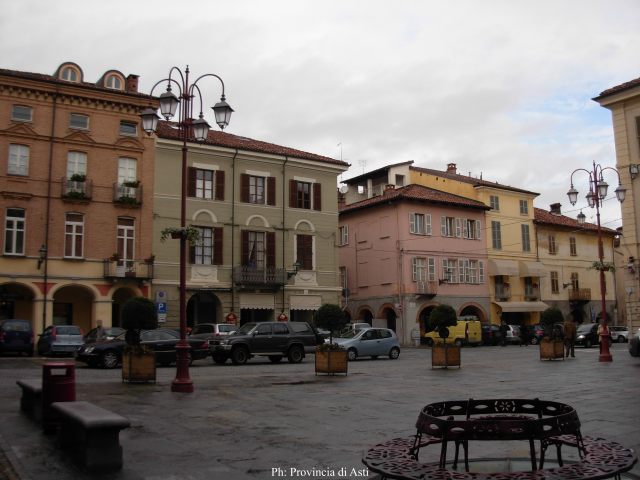San Damiano d'Asti
Last update 31 January 2024
From Sancti Damiani Oppidum to the title of city: San Damiano d'Asti, the “villa nova” jewel of High Monferrato
Landscape
San Damiano d'Asti is a city in the High Monferrato.
It is about 15 km from Asti, the provincial capital, and 45 km from Turin, the regional capital.
History
San Damiano d'Asti was founded in 1275 by the Astesi.
In the course of history, it is the domain of the Marquis of Monferrato, the Visconti, the Gonzaga and finally the Savoy (in 1631).
The city walls were gradually dismantled towards the end of the 18th century, and this transition also marked the beginning of the expansion of the town core.
Administration
San Damiano d'Asti gets the title of city in 2018.
San Damiano d'Asti is home to the Unione di Comuni Terre di Vini e di Tartufi.
Food and wine and typical products
San Damiano is known as a land of great wines, truffles, sweets (famous for the “sandamianesi”), and, above all, for its capon.
Occasions to taste them are the Fair of St. Joseph (Fiera di San Giuseppe), the oldest food and wine fair in Piedmont, the Fair of the Saints (Fiera dei Santi), the patronal festivals of St. Julius and that dedicated to Saints James and Grato, and the Borgo Rondò Festival (Festa del Borgo Rondò).
Dedicated to wines is the La Barbera incontra festival, three days with concerts, cultural meetings, entertainment, art, gastronomy, and tastings; for truffle lovers, on the other hand, the Regional Truffle Fair in November is worth mentioning.
Finally, in December, there is the Historical fair of the native capon of San Damiano d'Asti (Fiera storica del cappone nostrano di San Damiano d'Asti).
To be seen
The urban fabric of San Damiano d'Asti is developed on the original in medieval layout.
The artistic heritage of San Damiano is rich and original in form, such as the remarkable staircase that connects Piazza Camisola to Piazza 1275, where the Foro Boario is noteworthy.
Returning to the historic center, the most valuable buildings are Casa Castelli, Palazzo Vagnone, Palazzo Carlevaris (home of the town hall), Palazzo dei Conti Ceca di Vaglierano and Casa Demarie.
Staying nearby, the Clock Tower is also worth a visit.
In the northern part of the city, we find the former mandatory prison, used as a prison until 1964 and now home to the Enoteca Colline Alfieri dell’Astigiano.
Palazzo Pescarmona and Casa Daneo, on the other hand, represent the two most prestigious buildings in the southernmost area of San Damiano, namely the area of Baluardo Montebello.
In San Damiano there is also a civic museum and two castles: of the first, founded by Astesi in the Middle Ages, only the base of one of the circular towers remains.
In the hamlet territory, on the other hand, stands the Castle of Lavezzole.
Reviewing now the patrimony of ecclesiastical assets, an important place is occupied by the parish Church of Saints Cosma and Damian (Chiesa dei Santi Cosma e Damiano), the Confraternity of the Most Holy Annunciation (Confraternita della Santissima Annunziata), the Church of St. Joseph (Chiesa di San Giuseppe), and the parish Church of St. Vincent Martyr (Chiesa di San Vincenzo Martire).
In the hamlet of San Giulio, we also find the Church of St. Julius (Chiesa di San Giulio).
Finally, for outdoor enthusiasts, the presence of giant pencils and chairs and the “Sagrinte nen” street art path should be noted.
Insights
“Punti di Interesse”. Città di San Damiano d'Asti, www.comune.sandamiano.at.it/it/point-of-interests. Last accessed Jan. 28, 2024.
Curiosity
The bell tower of the parish church of San Damiano d'Asti recalls, according to the original design, the former presence of a castle, destroyed in 1617, of which it was one of the towers.
Today's function as a bell tower is a consequence of adaptation work on the primitive structure.
Data source
- Summary / reprocessing information taken from the institutional website (current and previous versions) of the Municipality of San Damiano d'Asti — https://www.comune.sandamiano.at.it/
- Cover image source: Provincia di Asti — https://www.provincia.asti.it
Insights
BeWeb - Beni Ecclesiastici in WEB
https://beweb.chiesacattolica.it/
Catalogo Generale dei Beni Culturali
https://catalogo.beniculturali.it/
Ente Turismo Langhe Monferrato Roero
https://www.visitlmr.it
GAL Basso Monferrato Astigiano
https://www.monferratoastigiano.it/
- Comune di San Damiano d'Asti (AT)
https://www.monferratoastigiano.it/comune-di-san-damiano-dasti-at/
Wikipedia, l'enciclopedia libera.
https://it.wikipedia.org
- San Damiano d'Asti
https://it.wikipedia.org/wiki/San_Damiano_d%27Asti
See also
News from San Damiano d'Asti
- Discover the latest news posted on the website of the Municipality of San Damiano d'Asti
https://www.comune.sandamiano.at.it/it/news
Events in San Damiano d'Asti
- Discover the events posted on the website of the Municipality of San Damiano d'Asti
https://www.comune.sandamiano.at.it/it/events
Social network | Municipality of San Damiano d'Asti
Follow your Municipality on social media:

